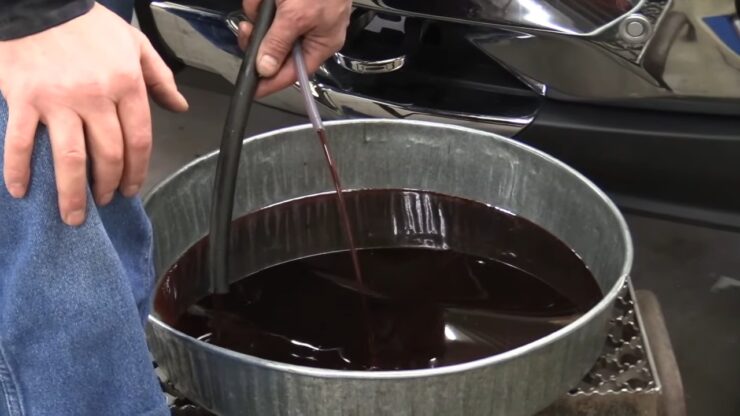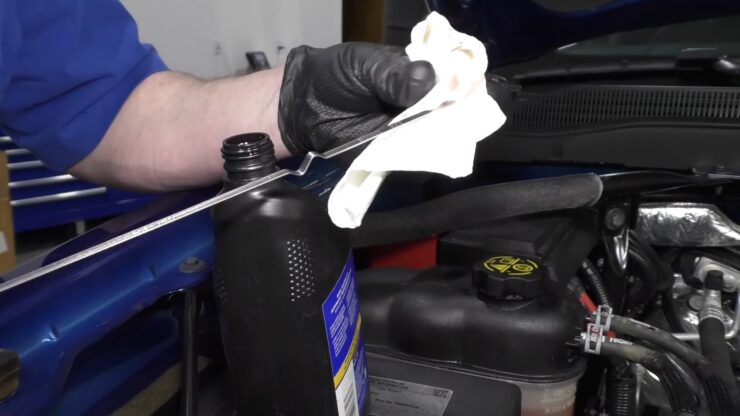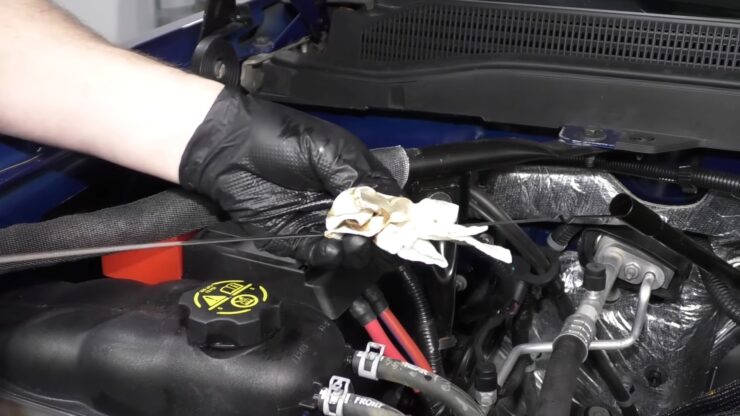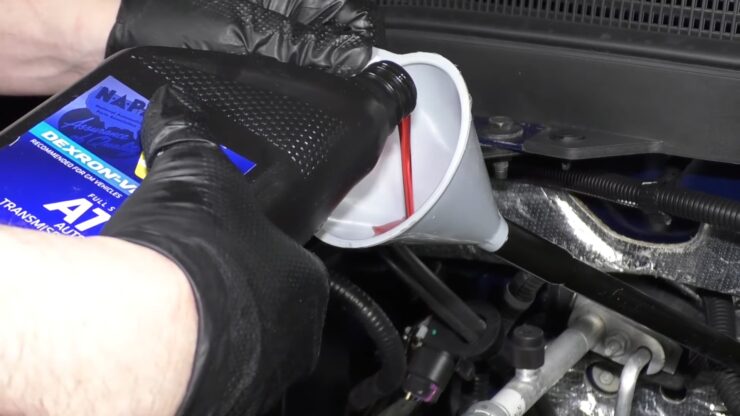The Chevy Silverado 1500 is an amazing pickup truck that has grabbed the attention of many. But with every other truck, maintenance is key.
In maintaining a Chevy Silverado 1500, the first thing you ought to know is how to change transmission fluid Chevy Silverado 1500.
How well you maintain a vehicle determines how smoothly it runs.
Proper monitoring of a Chevy Silverado 1500 transmission fluid is a continuous task that should be done regularly to ensure a smooth operation.
Vital information you need to know about transmission fluid for Chevy Silverado 1500 includes the transmission fluid type, how to change it, the capacity, and how to determine the type of transmission fluid for your vehicle.
This article will explain all these to equip every DIY enthusiast with what they need to maintain their Chevy Silverado 1500 themselves.
Table of Contents
Chevy Silverado Transmission Fluid Types
Generally, there are two main Chevrolet transmission fluid types: manual transmission fluid and automatic transmission fluid.
There are also synthetic transmission fluid and specialty Chevrolet transmission fluid types specified and used in various types of transmission, including dual-clutch and CVT models.
Manual transmission fluid
The manual transmission fluid is meant for older models of Chevy Silverado, and it is sometimes referred to as lube or manual transmission oil.
However, the manual transmission fluids are heavy, ranging from 75W to 140W, and are never used in automatic Chevy Silverado.
Automatic transmission fluid
Nevertheless, you can use this transmission fluid in some modern manual Chevy Silverado.
This automatic transmission fluid helps with various functions, including transmission cooling, brake band friction, torque converter operation, and gear lubrication.
Synthetic transmission fluid
Synthetic transmission fluid is a multi-vehicle transmission fluid that outperforms conventional transmission fluids.
One of the advantages synthetic transmission fluid has over conventional fluids is its exceptional thermal stability.
Generally, synthetic transmission fluid has been formulated to work with a wide variety of Chevy Silverado.
Specialty transmission fluid
Specialty transmission fluid is not a very common type of transmission fluid because it is specially designed for a certain transmission type.
Importantly, always use the recommended type of transmission fluid for your vehicle.
Specialty transmission fluid, for example, only works with the specified transmission, including dual-clutch and CVT models.
How to change transmission fluid Chevy Silverado 1500
To keep your car running smoothly, it is important to know a thing or two about the transmission fluid.
Schedule regular maintenance to ensure your Chevy Silverado 1500 runs smoothly to prevent the risk of early failure.
Below are the steps to follow to change transmission fluid on your car:
Step 1: Get your equipment ready
Firstly, get your kit ready for this process. Get a new transmission filter, ensure the one you get comes with a gasket, and then get an O-ring.
You also need screwdrivers, brake cleaner, longneck funnel, wheel chocks, mallet, and socket wrenches.
With these few tools, you can manage to change the transmission fluid yourself right from your garage.
Step 2: Prepare your Chevy Silverado
Getting the right equipment for the task is one thing; you also need to get your Chevy Silverado ready.
When the temperature of your car is optimal, you will be able to easily drain the transmission fluid. As such, it is advisable to let your car run for some minutes.
Thereafter, turn off the ignition system and pack the Chevy Silverado on an even surface. Under the catch pan, place a newspaper, and then from each side of the transmission pan, remove the bolts.
Step 3: Old fluid should be removed
Drain the transmission fluid by tilting the pan. However, you have to unscrew the bolts first.
When you must have removed those bolts, the next thing to do is to take the transmission pan lower. Thereafter, dump the remaining transmission fluid using the catch pan.
When done, install a new gasket.
Step 4: Remove the metal shavings
A very important step you should ensure you do is to clean the gasket surface.
While you are at it, let your eyes be on the housing and transmission pan. Inspect the pan in case there are any signs of damage, such as metal shavings, and remove them.
Step 5: Manage the filter
In this stage, make sure the old transmission filter is removed as well as the O-ring.
Note, the old transmission fluid may still be in the filter, so ensure you properly drain it before installing a new filter.
Step 6: Install a new filter and place the pan
Now that you have removed the bad fluid, you can then proceed to install a new filter.
But when installing the transmission filter, ensure the O-ring is properly placed. Also, take note of the transmission to keep the pan flat. When you fit the new gasket, ensure you make use of oil-soluble grease.
It also helps to avoid using gasket sealer and adhesive.
Step 7: Refill and test
Now that your new filter has been installed, you can now refill it with the right fluid.
Ensure you read the manufacturer’s instructions to ensure you do it properly. When refilled, you can run your car engine again.
Running the engine helps to warm up the newly added transmission fluid. Inspect the engine close to being sure there are no leaks.
Don’t also forget to monitor your Chevrolet Silverado operating temperature.
The last step to take is to check the transmission fluid level using a dipstick. However, you don’t have to overfill the transmission with fluid.
Note that a low fluid level is hazardous to your car, especially when you drive it.
Transmission fluid capacity Chevy Silverado
Chevy Silverado comes transmission fluid capacity varies depending on the year and type of transmission.
However, Chevy Silverado fluid capacity for automatic transmission is generally higher than for manual transmission.
For example, the Silverado transmission fluid capacity of most 1500 series is around 4.6 quarts, while the transmission capacity of most 3500 series Chevy Silverado takes around 3.7 quarts of transmission fluid.
Note, normally, the transmission fluid wouldn’t reduce unless it is overheated or there is a leak somewhere in the transmission.
Not to even mention that some cars do not have dipsticks to use to check the level of transmission.
But in such cases, there is a special procedure the user can use to check the level of the transmission fluid as well as to change it if need be.
How to Check Transmission Fluid Chevy Silverado 1500
Checking the transmission fluid for your Chevy Silverado is a maintenance routine that alerts you of minor issues before they become major issues.
Warm your car’s engine
Before you check your transmission fluid, warm up your engine.
So, turn the car on for 10-20 minutes to warm up before you start working on it. Park your car, then turn it off before you pop up the hood.
Locate the transmission fluid dipstick
Next, under the hood, locate where the car’s manufacturer designed the transmission fluid dipstick.
However, if you are unable to locate it, check the manufacturer’s manual for more details.
Pull the dipstick out
After locating the dipstick, pull it out of its holder.
Use your forefinger to observe the transmission fluid, moving it around between your thumb, checking for viscosity and color. Generally, if the transmission fluid is still in good condition, it should be clean or almost clean with a slightly pink tinge.
But if the transmission fluid smells like it’s burnt or discolored, then you should replace it.
Wipe the dipstick clean
To be sure of your observation, repeat your inspection of the transmission fluid. Dip the stick in the tube repeatedly, and clean the stick with a rag each time.
On the dipstick, there are two dots; the lower dot is the empty marker, while the upper dot is the full marker. If the transmission fluid is located between the two dots, you are good to go.
Refill if needed
But if you observe that the transmission fluid is located lower than the empty marker, then you need to top it up.
So, check the manufacturer’s user manual to confirm the type of fluid that is right for your car’s transmission.
When you figure it out, purchase it and use a funnel to slowly top up the transmission fluid carefully, but don’t overfill it.
How to Change Transmission Fluid Chevy Silverado 1500: FAQs
How much transmission fluid does a Chevy Silverado 1500 use in quartz?
The quantity of transmission fluid a Chevy Silverado 1500 takes depends on the year the model is made.
But generally, the quantity of fluid a transmission fluid takes varies between 6 quarts and eight quartz.
For example, the 2019 Silverado 5.3L V8 pickup truck can take 6 quarts of transmission oil, whereas the 2018 Chevrolet Silverado 1500 5.3L pickup truck takes 8 quarts of oil with a filter.
How often should you change the transmission fluid Chevy Silverado?
Chevy recommends you change your car’s transmission fluid every 30,000 – 60,000 miles, but this depends on your driving style and sometimes your car’s transmission type.
This is because, with time, both manual and automatic transmission fluid breaks down and becomes contaminated with debris and particles.
Unlike motor oil, the transmission fluid doesn’t need frequent changing. When transmission fluid is due for changing, you will notice a decrease in performance when engaging or shifting gears.
Which type of transmission fluid does a 2017 Chevy Silverado 1500 use?
Importantly, the transmission fluid you use on a Chevy Silverado is quite specific.
For the 2017 Chevy Silverado 1500, you can use any Carquest oil and fluids, like the Dexron ViATF.
You can experience a whole load of trouble when you use the wrong transmission fluid, including jerking, shudders, delayed shifts which will cause acceleration issues, and so on.
What should be my budget to replace the transmission in my Chevy Silverado?
Averagely, the cost of replacing a Chevy Silverado transmission ranged from $1800 to $3400.
To get a used transmission Chevy Silverado ranging from $800 to $1500, while to rebuild a transmission cost ranges from $1100 to $2800, and to remanufacture ranges from $1300 to $3400.
It is cheaper to rebuild a transmission than to replace it.
Does it matter what transmission fluid you use?
Yes, the transmission fluid you use matters, as using the wrong transmission fluid can affect your car’s transmission causing several issues.
As such, it is advisable to use whatever transmission fluid your car’s manufacturer recommends.
When you use a transmission fluid not recommended for your car can cause rough shifting, clutch locking up, gear that slips, gears that won’t shift, and stalling after changing gears.
How long does Chevy truck transmission last?
Often Chevy truck transmissions last up above 150,000 miles and below 200,000 miles.
Similarly, if your Chevy truck is a manual transmission, you can expect it to last up to 120,000 miles. Also, depending on your driving style, it can last well over 200,000 miles. Flushing your transmission is worth it. A common advantage of flushing transmission is the extension of your transmission’s life. As such, quite a few manufacturers recommend you flush your transmission every 30,000 miles or after every 2 years of use. However, not many recommend it this frequently. Some manufacturers recommend you flush your transmission only after about 100,000 miles, and others wouldn’t even recommend you flush it at all. Transmission fluid needs to be changed periodically. Failure to change the transmission fluid when needed will leave you with a grimy and dirty fluid that will fail to disperse heat or lubricate very well. So, how often you are to change the transmission fluid depends on your driving habits and your vehicle’s manufacturer’s recommendations. Truth be told, you can, but it is risky. If you drive at high mileage, you shouldn’t worry about transmission fluid. But if your transmission is running smooth and the fluid is first-class, maybe you can change it without issues, but it is not recommendable to change it at all on high mileage. Because if these things are not in place and you make the change anyway, it can cause transmission failure imminent. Luckily, changing the transmission fluid on your car can help fix several problems. So, you might be fortunate enough to change the transmission fluid, and issues bothering you for a while will automatically disappear. Common issues that changing transmission fluid can fix include the following points To sum things up, it’s important to understand how your Chevy Silverado works. However, learning how to change transmission fluid Chevy Silverado 1500 is undoubtfully beneficial. Because what keeps your car running smoothly is how well you maintain it. Also, your driving style takes its toll on your car. With only proper maintenance and driving style, you can avert some major expensive repairs. And this is only true if you notice when a thing changes in your car when it is well maintained. As such, brushing up your knowledge of transmission (or at least the basics) of your Chevy Silverado 1500 is highly recommended to help you avoid costly repairs. Because regular transmission maintenance can be done by anyone right from their home garage. However, simple information such as checking transmission fluid, transmission fluid types, changing transmission fluid helps you stay knowledgeable enough to avoid being over-repaired, simply ripped off, or overcharged. Always feel free to drop a comment in the comment section about your experience with your Chevy Silverado 1500 transmission fluid.Are transmission flushes worth it?
What happens if you don’t change transmission fluid?
Is changing transmission fluid bad on high mileage?
Can changing transmission fluid fix the problem?
Conclusion







